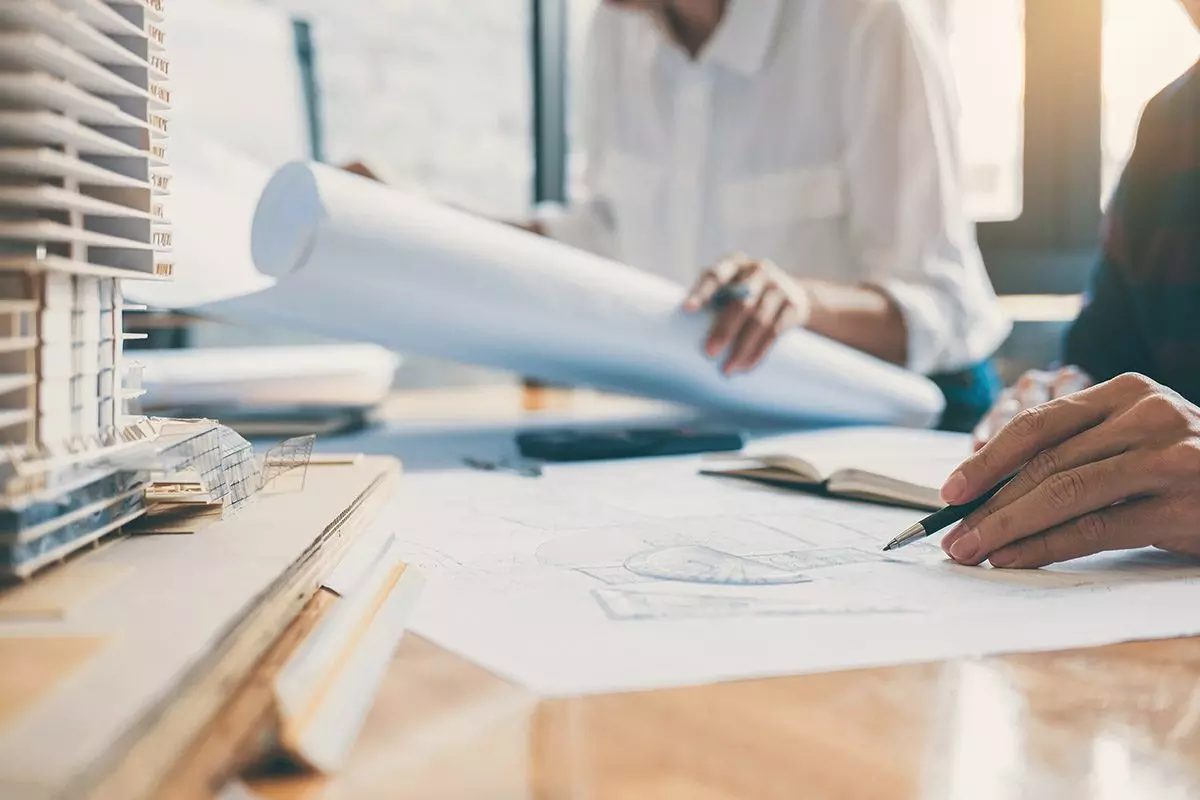Find out more about using architectural drawings during maintenance. Our meticulous drawings serve as invaluable guides, providing clear visual references to streamline maintenance processes for your property.
Architects Play a Vital Role in Building Maintenance
These buildings, whether they're homes, apartments, schools or towering skyscrapers, each play a critical role in our day-to-day lives. They provide shelter, workspace, education centres, and awe-inspiring cityscapes. But have you ever taken a moment to consider the individuals behind the ongoing care and preservation of these structures?
Architects are the unsung heroes who ensure the longevity and safety of our architectural landscape. While their initial designs are obviously pivotal, one aspect of their work that is frequently undervalued is the subsequent maintenance of these buildings throughout their lifespan. Through these elaborate blueprints, architects can guide others in how to correctly maintain the building, ensure its durability and extend its safe usage.
Architectural drawings, also referred to as a building's life map or blueprint, play an integral role in the construction industry. These drawings serve as the guiding light for both the construction and maintenance teams. Encompassing the creative vision of the design, they seamlessly tie together the artistic concept of a building with its physical, practical execution. Architects are responsible for creating these drawings, otherwise known as 'design drawings'. The sole purpose of these drawings is to ensure the constructed buildings not only attract admiration for their aesthetics, but also fulfil their functional roles and comply with safety norms.
A balanced blend of aesthetic appeal, practicality, and safety is the key to successful architecture. The use of architectural drawings facilitates this balanced blend, bridging the gap between abstract vision and concrete reality. Besides, these drawings are essential for outlining detailed specifications and measurements, helping avoid costly and time-consuming errors during construction. In summary, architectural drawings serve as an essential roadmap leading to the creation of safe, functional, and aesthetically pleasing buildings.
Searching for architects near me? Contact our London-based architectural firm for architectural drawings in Twickenham, Richmond and the surrounding areas.
How Do Builders Use Architectural Drawings?
Architectural drawings are often referred to by builders as the GPS of the construction world, acting as the essential roadmap for any construction project.
These precise sketches provide them with the necessary guidance regarding design, layout, building dimensions and even the specifications of materials required for each particular stage of the project.
Detailed instruction for implementing aspects such as walls construction, installation of electrical wiring or fitting of various types of pipes are beautifully depicted on these blueprints.
Moreover, these drawings play a crucial role in ensuring safe construction practices; they embed detailed safety protocols and measures to be strictly adhered to during both the construction phase and subsequent maintenance work. Therefore, it's not just about what the building will look like, but also how it will be safely and effectively built and maintained.

Defining Maintenance for Building Design
To grasp the various facets of maintenance, it's crucial to first familiarise yourself with its different types. There are primarily two sorts: planned and scheduled maintenance. These services are prearranged and follow the prescribed procedures outlined in the original design drawings. The aim of these maintenance types is to prevent emergencies and unanticipated problems by prioritising diligent preparation over impulsive responses. Examples of such scheduled checks might include periodic inspections of your building's heating, ventilation, and air conditioning (HVAC) systems or a routine examination of the roof conditions. Both of these checks are vital in maintaining the integrity and safety of a property.
By better understanding maintenance types, you can ensure your property is always in prime condition. Preventative maintenance concentrates on resolving minor issues before they grow into considerable problems, hence saving you time, money, and possible disruption. Tasks include tightening loose fixtures and fastenings, sealing small leaks and replacing worn-out components before they fail. This proactive approach utilises maintenance drawings. These technical illustrations offer detailed insight into the structure of the item, demonstrating precisely where each part fits and how it operates.
This information is vital for proper upkeep and ensures operators can carry out their tasks efficiently, minimising the chance of major issues occurring down the line. Corrective maintenance is a crucial process in which faults and failures are identified and promptly fixed, preventing structural damage and fostering a secure environment. Conversely, proactive maintenance takes a preventative approach, constantly examining elements of the building for any potential issues before they develop into a problem.
Unexpected emergencies such as unforeseen defects or accidents are dealt with via unplanned maintenance. This work is done swiftly to rectify immediate problems and reduce downtime. All these types of maintenance are fundamentally linked to the building's 'architectural lines for drawing,' which are essentially the blueprint guiding the building's construction and maintenance. By adhering to this design, it ensures the longevity of the structure and its continued safe use by its occupants. It's essential to grasp the significance of each type of maintenance to ensure buildings remain in optimal condition.
What Types of Construction Work Require Architectural Drawings?
Architectural drawings are integral in every facet of construction and maintenance, be it in the designing of a fresh, new building, or the refurbishing of an old, ageing one. These blueprints are crucial, regardless of the scale or complexity of the task at hand.
It could be something as simple as erecting a new wall, or something more complicated like updating HVAC systems, rewiring electric lines, or updating plumbing. This also extends to maintenance tasks. Tasks such as locating hidden leaks behind walls, carrying out sewer line inspections, or undertaking structural assessments in the event of potential renovations are all heavily reliant on these drawings.
Architectural drawings provide an internal mapping of the structure, acting very much like a building's fingerprint. The inclusion of every detail, no matter how minute, reduces the need for guesswork, guesswork that can often lead to costly mistakes. These drawings clarify complex construction details and serve as a guide for builders, enhancing their efficiency.
Thus, architectural drawings aren't just a requirement, they're an absolute necessity, a tool that ensures the construction or maintenance task at hand is conducted in the most effective and efficient manner.
With them, the vision of the architect is laid out in precise detail, paving the way for the smooth progression of construction or refurbishment. They are the language builders speak, ensuring everyone is on the same page.

Displaying Materials Accurately in Architectural Drawings
Architectural drawings, a fundamental element in the construction world, often do not receive the attention they deserve, especially when it comes to revealing the materials to be utilised. This underestimation can lead to significant drawbacks. Arguably, the most crucial detail in these blueprints is their ability to accurately disclose the intended materials. This not only influences the scope of the project but directly impacts the safety, sustainability and durability of the final structures. A minor misinterpretation or inaccurate documentation can compromise the integrity of the building, posing potential hazards.
Furthermore, these technical papers contain crucial information about the environmental impact of a project. By accurately outlining the materials to be used, they convey essential data about the sustainability of the construction process. Similarly, they provide insights into the durability of a building. Materials detailed in the drawings influence the building lifespan, maintenance requirements and cost. Therefore, undervaluing the importance of accurate material disclosure in architectural drawings can lead to unfavourable outcomes. Recognising this aspect may result in safer, more sustainable and long-lasting buildings, contributing positively to the built environment.
Contact your architect or architectural firm if you have queries about the materials listed on your architectural drawings for reassurance and clarify. They should be more than willing to explain and instil confidence in the materials they have chosen to utilise in your project. For instance, the grade and type of steel used in a building withstand different levels of stress. Therefore, the builders and maintenance teams must be aware of this information to take appropriate action. Accurate architectural drawings can save valuable time, avoid unnecessary expenditure and ensure that the right materials are used to maintain building standards.
architectural Drawings Near Me
If you are looking for property conversion architectural drawing services throughout Hounslow, Twickenham and the greater London area, then get in contact with our team today. We can offer advice and begin guiding you towards making the right decision.
Bob Trimble is a chartered architect registered with RIBA. Bob Trimble has 30 years of experience working with residential and commercial property projects. For 4 years, Bob Trimble has worked from his housing association and private architectural practice for clients throughout Hounslow, Twickenham, Richmond, Kingston Upon Thames, Teddington and the surrounding areas of London.


